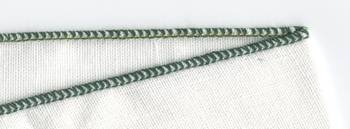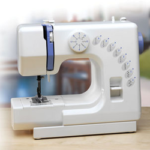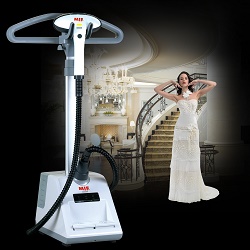What seams can be performed on the overlock
Overlock allows you to sew a perfect product. Due to its multifunctionality, it can not only sweep over the edges, preventing spilling of the fabric at the cut point, but at the same time sew elements together and also decorate the product. These functions are performed due to the variety of overlock seams.
Content
Classic overlock lines
Processing the edge of the product can be doable on a sewing machine, but if you compare it with a line made on the overlock, the result will vary greatly. The seam, made on the overlock, is more reliable and has a more aesthetic look. Consider in detail the common lines that can be made on the overlock machine.
- 2 filament stitch performed mainly on very thin fabrics where a minimum of threads is necessary.
 Since overlocks for the most part provide for 3 or more threads in a line, you need to make sure that there is a converter in the model. It is a special clamp that overlaps the upper looper. To perform this type of seam need one needle and one lower looper.
Since overlocks for the most part provide for 3 or more threads in a line, you need to make sure that there is a converter in the model. It is a special clamp that overlaps the upper looper. To perform this type of seam need one needle and one lower looper. - 3-thread suture is the most common and can be performed by any modern or old overlock ten years ago.

If the lines in 3 threads are enough for the intended garments, then you can save a lot of money, as these machines are the most budget. The line making technology is simple. The needle makes the top stitches, the bottom looper performs a parallel stitch at the bottom, and the top stitch connects 2 stitches with a thread helix. Such a seam can be used absolutely for any type of fabric. - 4 filament stitch On the overlock, you can not only sweep over the edges, but also sew fabric cuts. It is especially convenient for them to work when stitching knitwear.

The stitching is done with 2 needles and loopers. It is strong enough and suitable for elastic fabrics. - 5 filament stitch can be performed with the help of 3 needles on a modern overlock.Also, such a line is made by a carpetlock, equipped with a special lower looper for a chain stitch.

Such a seam is easier to work with very "naughty" fabrics. Especially, if massive details are stitched into them: lightning, brooches, large buttons. 5-thread line makes the seam more durable. It can be seen on summer women's blouses from crepe de chine, chiffon, organza and other thin naughty fabrics.
Decorative seams
Modern models overlock provide more opportunities for sewing exclusive things, as they can please with decorative types of stitching.
Flatlock
Flatlock is most common in this category. It can be performed on any overlock with a certain adjustment.

To create such a seam, the tension of the needle threads is weakened while the lower loopers are maximum tensioned.. A line of Flatlock can be stitched fabric elements. At the turn, when connecting 2 layers of material, a line resembling a flat seam is formed. In the sock it is not very durable, in places of high load it quickly disperses, therefore it is rarely used in sewing. More such line is suitable for decorating embossed elements clothes.
Role-playing
It is also called roller seam or opikka, it is possible to get by means of manipulations with the adjustment of overlock tensioners. Edge processing looks like a line twisted inside.

With the help of such a hem on the product, you can increase the waves on the frills by inserting a fishing line, make the skirt edge more elastic. This maneuver is used for overcasting the edge of the petticoat to increase the pomp of the hem. With it, you can not only process the edges of the fabric, but also simultaneously sew the frills of the attire together. Often this line is used in tailoring dance costumes. The role seam also looks beautiful on decorated parts of tulle and knitwear.
To perform a roller seam, it is necessary to reduce the stitch length to a minimum and change the stitch width.. This is done as follows: a tongue is built in the overlock near the coal plate, which serves as a barrier to the curl of the fabric. The desired line is formed if you perform it without a given tongue. In this case, the result is a twisted, machined seam.
Double sided
The flat seam with the upper zastilom can be created on advanced machines, which are provided for the simultaneous use of a large number of threads.Due to the interlacing of 5-10 dressed yarns, you can get beautiful lines that make beautiful prints on the product. Such a double-sided seam is used, as a rule, not for processing the edge of the product, but for making jewelry on clothes.

Taking into account the possibilities of the overlock and the quality of overlapping seams, it is advisable to purchase additional tiller device. Properly selected sewing equipment will contribute to the implementation of sewing ideas, and help to achieve good results of design decisions.
Recommendations on the choice of finishing seams
The overlock machine includes such elements for performing work that allow you to maximally maneuver in creating an overline. The presence of additional nozzles, a cut-off width regulator, a knife, a hose platform favorably distinguishes the overlock from the sewing machine in processing the fabric edges.
It is necessary to remember a few important points.
- Choosing an overlock only for the possibility of high-quality overlay, a 2-3 threading machine will do. To be able to perform a decorative stitch, it is better to take an overlock with a 4-phono overlay.
- Having differential feed function, you can safely work with very elastic fabrics and perform complex assemblies and shuttlecocks.
- By adjusting the width of the cut, depending on the density of the fabric, you can try different versions of the same stitch. For example, a neater stitch on thick fabric will increase with a cut-off distance for a role-playing seam, and to work with a thin fabric, you need to reduce the distance.
Overlochny machine must be purchased with the presence of those functions that will best meet the needs. Limited use does not require large investments, and, on the contrary, if you want to create exclusive products, it is better to think in advance about the presence of important additional overlock functions.

/rating_off.png)












